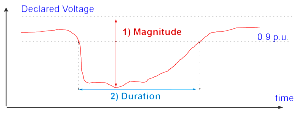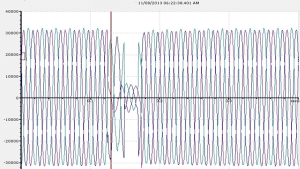Definition: Temporary reduction of the r.m.s voltage at a point in the electrical system below 90% threshold of the declared nominal voltage, between 10ms and up to a minute.

Simply speaking, a sudden voltage drop of more than 10% of the declared nominal voltage. The utility in Singapore has in place a Power Quality Monitoring System (PQMS) from 22kV voltage level upwards (all the way to 400kV). These are three-wire three phase systems; and hence line to line voltages are used in defining a dip.
There is a significance of such definition being used in the 66kV and 22kV networks, whereby it is a resistively earthed grounded system (thru the neutral ground resistor). Here, a single phase fault will not be a registered as a voltage dip as the other two non-faulted phases will swell; ‘compensating’ the faulted phase. This will result in a drop of voltage (line to line) of usually less than 10% (hence not a dip). The utility here described such events as ‘Voltage variation’.
Two things matter when it comes to describing a voltage dip.
1) Magnitude of the dip
This typically reflects the fault severity and also the proximity of the monitoring point to the fault location.
2) Duration
The timer starts when the voltage falls below the 90% threshold and ends when all voltages are equal to or above the 90% threshold. This is very much dependent on the time taken to isolate the fault and the nature of loads connected.
Normally a voltage dip here in Singapore will lasts less than 200ms (10 cycles). This is about the average time the primary protection takes to isolate the fault from the network.
Usually a longer duration will suggest a somewhat sluggish protection relay operation.
Typical causes of a voltage dip in Singapore:
1) Equipment / cable faults in the utility network.
2) Equipment / transmission line faults in Tenaga Nasional Berhad (TNB) network (Singapore is connected to Malaysia at 230kV).
3) Customer Installation faults.
4) Cable damage by earthworks.
5) And to a very small extent, load switching like motor starting.
Singapore’s electricity regulator, the Energy Market Authority (EMA) publishes cases of voltage dips on its website.
